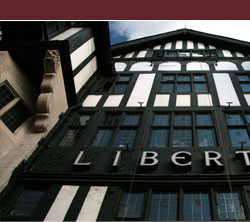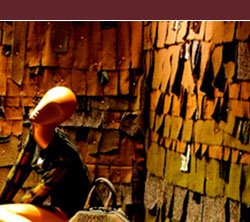In 1875 Liberty shop opened in Regent Street and very soon after that Arthur Liberty had printed the first of the soon to be famous Liberty silks. This was a hand-woven Mysore silk imported from India, which was dyed in England and then hand-printed with wood blocks. Most of the prints were reproductions of old Indian prints. The small floral designs were devised in consultation with authorities at the newly established Indian Museum and they were given exotic Indian names such as Tajore Lotus and Rangoon Poppy. Arthur Wardle showed a collection of these Liberty silks at the Paris Exhibition in 1878.
 In 1904 Liberty bought Littler's, a small print works at Merton which had been hand-printing Liberty fabrics since the late 1870s. The works were on the site of a pre-Reformation priory on the river Wandle in Surrey. William Morris had established a print works in 1881 downstream on the opposite bank to the workshops Liberty was rapidly taking over. So it was that the district surrounding Merton Abbey continued as a community associated with textiles that had begun when a group of Huguenots established a silk-weaving factory on the site in the early eighteenth century. In 1904 Liberty bought Littler's, a small print works at Merton which had been hand-printing Liberty fabrics since the late 1870s. The works were on the site of a pre-Reformation priory on the river Wandle in Surrey. William Morris had established a print works in 1881 downstream on the opposite bank to the workshops Liberty was rapidly taking over. So it was that the district surrounding Merton Abbey continued as a community associated with textiles that had begun when a group of Huguenots established a silk-weaving factory on the site in the early eighteenth century.
No-one could ever dispute neither the quality of Liberty fabrics nor the exceptional beauty of the designs and colours. Indeed the waters of the river Wandle were of the special quality required for the rich, subtle hues of madder dyeing. Liberty commissioned many distinguished artists and designers to design prints for their textiles and the range of fabrics was extended to include furnishing fabrics.
Even today designers for Liberty come and visit the archive for inspiration. New designs are either designed by the in-house Studio or are commissioned from free-lance designers. New designs are introduced in the spring and autumn of each year to complement the range of classic designs that are not so bound to the seasons. Some of these latter designs, such as Peacock Feather, date back to the 1880s.
The fabrics are now all machine printed using either the flat bed or rotation methods. The fabrics are sold worldwide to manufacturers and retailers. Liberty fabrics currently available include: tana lawn, kingly cord, jersey, varuna wool and crepe de chine.
|







